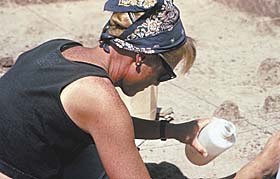  |
| HOME | THIS ISSUE | CALENDAR | GRANTS | BACK ISSUES | < BACK | NEXT > |
Archaeologist finds first fossil evidence of chimps in Kenyaby Cindy Weiss - September 7, 2005 |
||||
|
The discovery of the first fossil chimpanzee in Kenya’s Rift Valley is reported in a paper co-authored by UConn professor of anthropology Sally McBrearty in the Sept. 1 issue of the international science journal Nature. McBrearty found four fossil chimpanzee teeth during her archaeological research in summer 2004 in the Rift Valley of Kenya. She says she and anthropologist Nina Jablonski of the California Academy of Sciences, co-author of the paper, were very surprised with the find: no one had ever found a chimpanzee fossil before. “We were going through the fossils near the end of the season and I realized they were something interesting,” says McBrearty. After analyzing them at the National Museums of Kenya and consulting with paleontologist Meave Leakey, they identified the teeth as those of a chimpanzee of the genus Pan. It lived about 500,000 years ago and died at the age of about seven or eight. Most scientists are looking for human fossils, McBrearty says, and it was assumed that humans – but not chimps – lived in the Rift Valley. The valley, a dry environment, was thought to have been a barrier to chimpanzees, who stayed in the rain forest where they live today. It was even proposed that this type of barrier might have caused the separation of the chimp and human lines 7 million years ago, McBrearty says: humans adapted to the savannah and began to walk on two legs, while chimpanzees, the closest living relative of humans, stayed in the rain forest and remained quadrupeds. Finding the chimp fossils in an area where humans lived at the same time means “that scenario is out,” she says. “As an archaeologist, it’s interesting to imagine how they might have interacted with each other,” she adds. The find shows that both chimps and humans were able to adapt to a drier environment, and that chimps had a range that included East Africa, some 600 kilometers east of where they live today, she noted.
It also suggests that the Rift was more densely wooded 500,000 years ago, and that more animals lived there, before the trees were cut down by people. Fossils of Homo erectus or Homo rhodesiensis, were found in the 1960s and 1980s in this same area, dating to the same time period. These human species immediately preceded the current human species, Homo sapiens, which first appeared about 300,000 years ago. The chimp fossils were found in an open area that had been exposed by erosion. Half a million years ago, it would have been close to the shore of Lake Baringo, which is now several kilometers to the west. The anthropologists have not been able to identify the species of the chimp fossils; McBrearty says the teeth may have belonged to a species now unknown. She hopes to continue digging in the area, perhaps this fall, and to unearth additional fossils. It’s possible that other chimp fossils exist in museum collections and have not been properly identified, she notes. She expects her find “will make people go back to the museum collections that already exist” to look for similarities. The Sept. 1 issue of Nature, containing McBrearty and Jablonski’s paper, “First Fossil Chimpanzee,” also features a chimp on the cover; another paper in the issue describes the first sequencing of the chimp genome. McBrearty, who came to UConn 10 years ago from Brandeis University, has worked in East Africa for 30 years. Her work is concentrated in the Kapthurin Formation, a large area with about 60 fossil sites near Lake Baringo in Kenya. She is affiliated with the National Museums of Kenya. Her research has been funded by the National Science Foundation almost continuously since 1993. |
| ADVANCE HOME UCONN HOME |

